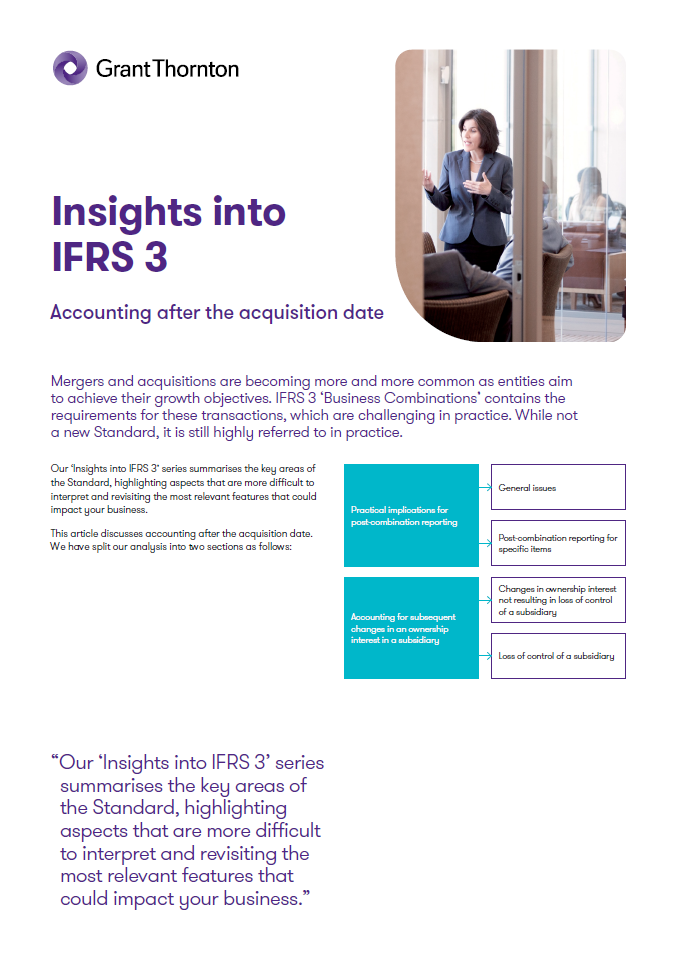
Mergers and acquisitions are becoming more and more common as entities aim to achieve their growth objectives. IFRS 3 ‘Business Combinations’ contains the requirements for these transactions, which are challenging in practice. While not a new Standard, it is still highly referred to in practice.
This article discusses accounting after the acquisition date. We have split our analysis into two sections as follows:
- General issues,
- Post-combination reporting for specific items.
- Changes in ownership interest not resulting in loss of control of a subsidiary,
- Loss of control of a subsidiary.
Practical implications for post-combination reporting
General issues
The parent entity is required to undertake a number of practical steps in order to prepare financial statements that include the acquired subsidiary (both for the first post-combination reporting date and subsequently). The following table highlights some key accounting policy and procedure considerations that should be addressed in the initial consolidation of the acquired subsidiary, and in the subsequent accounting by the subsidiary as part of the group. The parent will also need to consider the impact on the subsidiary's reporting systems, processes and procedures to ensure the appropriate consolidation information is captured.
Please note that the following lists are not exhaustive, and there may be other matters specific to each business combination that also need to be considered.
| Accounting requirements | Matters for consideration |
|---|---|
|
Align the acquired subsidiary's accounting policies with those used for the consolidated financial statements
|
Review the consistency of the acquired subsidiary's accounting policies and estimates with those of the parent's.
Areas where differences often arise include:
|
|
Align the accounting period of the subsidiary with that of the parent.
Note: IFRS 10 ‘Consolidated Financial Statements’ allows a parent to use a subsidiary's financial statements prepared at a different reporting date. However, the difference in the reporting dates cannot exceed three months. In addition, the parent is required to make adjustments to account for the effects of significant transactions or events between the reporting dates of the parent and the subsidiary.
|
The financial statements of the acquired subsidiary, used by the parent to prepare consolidated financial statements, should cover the same financial period as that of the parent/existing group financial statements.
|
|
Classify and designate assets acquired and liabilities assumed
|
The subsidiary's assets and liabilities should be classified and designated based on their contractual terms, economic conditions and the parent's accounting policies.
This designation is done on the basis of the above factors as at the acquisition date. There is however an exception for leases in which the acquirer is acting as a lessor. These contracts shall be classified as operating or finance leases based on the contractual terms and other factors as at the inception of the contract, or at the date of any subsequent modification of contractual terms that would lead to a change in classification (which may be the acquisition date).
See ‘Insights into IFRS 3 – Specific recognition and measurement provisions’ for further information.
|
|
Allocate goodwill to cash generating units (CGUs) or groups of CGUs and test for impairment (see IAS 36 ‘Impairment of Assets’)
|
Any goodwill arising as a result of an acquisition must be allocated to a CGU (or group of CGUs).
Before the end of the reporting period, test any CGU to which goodwill is allocated for impairment.
Note that any goodwill arising from the acquisition of a foreign operation along with any FV adjustments to assets or liabilities acquired, are treated as assets and liabilities of the foreign operation and therefore need to be recognised in the functional currency of the foreign operation and translated at closing rates in accordance with IAS 21 ‘The Effects of Changes in Foreign Exchange Rates’.
When the initial accounting for the business combination is incomplete as of the first reporting date. See Insights into IFRS 3 - Business combinations where the accounting is incomplete at the reporting date, and allocation of goodwill also cannot be completed, the parent:
|
|
Update segment reporting disclosures
|
A parent that applies IFRS 8 ‘Operating Segments’ needs to determine the impact of the acquisition on its segment disclosures. It may result in a new reportable segment, an addition to an existing reportable segment or part of a non-reportable segment (which may cause such a segment to exceed the quantitative threshold for reporting).
Under IFRS 8, changes in segment disclosures are triggered when a change is made in the component information reported to the chief operating decision maker.
|
Post-combination reporting for specific items
IFRS 3 is not intended to provide guidance on the subsequent measurement and accounting of items recognised in a business combination. In general, an acquirer shall measure and account for assets acquired, liabilities assumed or incurred, and equity instruments issued in a business combination in accordance with other applicable IFRSs depending on the nature of those items.
However for a limited number of items, specific guidance is provided on how they should be subsequently accounted for, as follows. You can also refer to our article ‘Insights into IFRS 3 – Specific recognition and measurement provisions’.
| Asset or liability | Specific IFRS 3 guidance |
|---|---|
|
Reacquired rights (eg A right previously granted to the acquiree to use the acquirers trade name)
|
Amortised over the remaining contractual period of the original contract, excluding any renewal period.
If the reacquired right is subsequently sold to a third party, the carrying amount of the intangible asset is included in the determination of the gain or loss on sale.
|
|
Contingent liabilities
|
After initial recognition and until the liability is settled, cancelled or expires, contingent liabilities shall be measured at the higher of:
This requirement does not apply to contracts accounted for in accordance with IFRS 9 ‘Financial Instruments’. |
|
Indemnification assets (recognised as a result of contractual indemnification provided to the acquirer)
|
Any recognised indemnification asset is subsequently measured at each reporting date on the same basis as the indemnified liability or asset, subject to any contractual limitations on its amount. If the indemnification asset is not subsequently measured at fair value, the valuation used should consider management's assessment of its collectability.
The indemnification asset is only derecognised when the acquirer collects, sells or otherwise loses the right to the asset.
|
|
Contingent consideration
|
Changes in the fair value of contingent consideration (other than measurement period adjustments – see ‘Insights into IFRS 3 – Consideration transferred’) are accounted for as follows:
|
The following examples illustrate aspects of the guidance that can be found in IFRS 3:
Example 1 – Contingent consideration liability
Entity X acquired Entity Y on 31 December 20X1. The purchase agreement included a contingent consideration clause that requires Entity X to issue an additional number of shares equivalent to CU100,000 if the average profits of Entity Y in 20X2 and 20X3 exceed a target level. On the acquisition date, the fair value of the contingent consideration was determined to be CU36,281 based on an assumed discount rate and a 40% probability that Entity Y will achieve its profit target.
Subsequent events information:
- In 20X2, Entity Y's performance exceeds forecasts and at 31 December 20X2, Entity X considers that it is 80% probable that the profit target will be achieved.
- On 31 December 20X3, Entity Y has achieved its target. The additional shares are issued on 7 Jan 20X4. The fair value of Entity X's shares on that date is CU16.
Analysis
In this situation, the contingent consideration arrangement requires the issuance of a variable number of shares equal to a fixed monetary amount. Accordingly, it is classified as a liability at the acquisition date and is remeasured at each reporting date until settlement or expiry.
At 31 December 20X2, the fair value of the contingent consideration is determined to be CU76,190. The change in the estimate results from changed circumstances during 20X2 (Y's performance was better than anticipated) and the passage of time rather than arising from additional information relating to conditions at the acquisition date. Consequently, the change in fair value of CU39,909 (CU76,190 - CU36,281) is recognised in profit or loss.
At 31 December 20X3, the recorded liability is increased to CU100,000 by recording an additional expense of CU23,810 (CU100,000 - CU76,190).
On 7 January 20X4, 6,250 shares (CU100,000 / CU16 per share) are issued to settle the liability.
Example 2 – Contingent liability with a related indemnification asset
As part of its acquisition of Entity X, Entity W assumed a contingent liability in respect of a third-party litigation. The former owner of Entity X agreed to reimburse Entity W for the losses from the litigation up to CU100. On the acquisition date, Entity W concludes that the lawsuit gives rise to a present obligation and determines that the acquisition date fair value of the contingent liability is CU40. In accounting for the business combination, Entity W recognises a contingent liability of CU40.
At the same time, Entity W recognises a CU40 indemnification asset for the former owner's promise to reimburse up to CU100. The indemnification asset is measured on the same basis as the related contingent liability. Note we have assumed that there is no uncertainty about the recoverability of the indemnification asset.
At the next reporting date, Entity W determines that the amount that would be recognised under IAS 37 for the contingent liability is CU120, based on developments in the case after the acquisition date. The liability measured in accordance with IAS 37 is the best estimate of the expenditure required to settle the contingent liability at the end of the reporting period.
Analysis
The CU120 exceeds the amount recognised at acquisition, so Entity W remeasures the recorded contingent liability to CU120. Entity W also recognises an increase in the value of the indemnification asset, measured on the same basis as the contingent liability. However, the asset is capped at the CU100 promised by Entity X's former owner. A net expense of CU20 is recognised in profit or loss.
Accounting for subsequent changes in an ownership interest in a subsidiary
A change in the parent's ownership interest in a subsidiary may result from a purchase or sale of shares by the parent or from transactions between the subsidiary and non-controlling interests.
This section discusses the accounting for changes in ownership interests that:
- Do not result in loss of control of the subsidiary
- Do result in loss of control of the subsidiary.
The accounting for increases in ownership which result in the gaining of control of a subsidiary have been discussed in our article Insights into IFRS 3 – Recognising and measuring goodwill or gain from a bargain purchase.
Changes in ownership interest that do not result in loss of control
Non-controlling interests (NCI) in a subsidiary are presented as a separate component of equity in the consolidated statement of financial position. Consequently, changes in a parent's ownership interest in a subsidiary that do not result in loss of control are accounted for as equity transactions.
Parent's accounting treatment:
- No gain or loss is recognised when the parent sells shares in the subsidiary (ie increasing NCI).
- A parent’s purchase of additional shares in the subsidiary (ie reducing NCI) does not result in additional goodwill or other adjustments to the initial accounting for the business combination.
- In both situations, the carrying amount of the parent’s equity and NCI's share of equity is adjusted to reflect changes in their relative ownership interest in the subsidiary. Any difference between the amount of NCI adjustment and the fair value of the consideration received or paid is recognised in equity, attributed to the parent (this can be retained earnings, or another component of equity).
- The parent should also take the following into consideration:
- The allocated amounts of accumulated other comprehensive income (OCI) (including cumulative exchange differences relating to foreign operations) are adjusted to reflect the changed ownership interests of the parent and the NCI. The re-attribution of accumulated OCI is similarly treated as an equity transaction (ie a transfer between the parent and the NCI).
- For a partial disposal of a subsidiary with foreign operations, the parent re-attributes the proportionate share of cumulative exchange differences recognised in OCI to NCI in that foreign operation.
- IFRS 10 does not have any specific guidance for costs directly related to changes in ownership interests but, in our view, costs that are incremental should be deducted from equity (consistent with the rules in IAS 32 ‘Financial Instruments: Presentation’ on other types of transaction in the entity's own equity). Other IFRS Accounting Standards do not contain guidance about where in equity this should be deducted from.
The following examples illustrate IFRS 10's requirements. Where relevant, the examples also illustrate how the adjustment to the carrying amount of NCI is determined under the two NCI measurement models (see ‘Insights into IFRS 3 – Recognising and measuring non-controlling interest’).
Example 3 – Parent sells shares in a subsidiary
Entity A acquired 80% of Entity B in 20X6. On 1 January 20X9, Entity A sells Entity B shares equivalent to 20% of Entity B's outstanding shares for CU260. On that date, the carrying value of Entity B's net assets in the consolidated financial statements, excluding goodwill, amounted to CU900. Goodwill measured using the fair value and proportionate interest model amounts to CU230 and CU200, respectively. Entity A's recorded goodwill is not impaired. Entity B has no accumulated OCI. After the sale, Entity A still has a 60% interest in Entity B and continues to control its operations.
Analysis
Adjustments to NCI and equity in Entity A:
| NCI at fair value model CU |
NCI at proportionate interest model CU |
|
|---|---|---|
|
Carrying value of Entity B's net assets
|
900
|
900
|
|
Goodwill recognised at acquisition
|
230
|
200
|
|
Carrying amount - 1 January 20X9
|
1130
|
1100
|
|
Cash consideration received
|
260
|
260
|
|
Less additional NCI to be recognised (20% of carrying amount)
|
(226)
|
(220)
|
|
Amount to be credited to parent's equity
|
34
|
40
|
The choice of recording NCI either using the fair value or proportionate interest model only applies on the acquisition date. Adjustment to NCI is based on NCI's proportionate share of the subsidiary.
Example 4 – Parent acquires additional shares in a subsidiary
Entity C has an 80% interest in Entity D. On the acquisition date, NCI measured using the fair value and proportionate interest model amounts to CU180 and CU150, respectively. On 1 January 20X9, Entity C purchases the remaining 20% interest in Entity D for CU280. Entity C's recorded goodwill is not impaired. From the date of acquisition up to 1 January 20X9, the balance of NCI has increased by CU80 related to the NCI's share of Entity B's profits (CU70) and other comprehensive income (CU10).
Analysis
Adjustments to NCI and equity in Entity C:
| NCI at fair value model CU |
NCI at proportionate interest model CU |
|
|---|---|---|
|
NCI recognised on acquisition date
|
180
|
150
|
|
NCI's accumulated share of profits
|
70
|
70
|
|
NCI's accumulated share of other comprehensive income
|
10
|
10
|
|
Carrying amount of NCI - 1 January 20X9
|
260
|
230
|
|
Cash consideration paid
|
280
|
280
|
|
Less amount debited to NCI (carrying amount)
|
260
|
230
|
|
Amount to be debited to parent's equity
|
20
|
50
|
With the change in ownership interest, the NCI's share of the accumulated OCI is re-attributed to the parent and will be included in the balance of accumulated OCI. Entity C will then record the following entry:
| Debit CU |
Credit CU |
|
|---|---|---|
|
Equity
|
10
|
|
|
Accumulated OCI
|
10
|
Accounting for the loss of control of a subsidiary
The loss of control of a subsidiary usually occurs when the parent sells or otherwise transfers its controlling interest in a single transaction or as a result of multiple transactions. However, other events may also result in the loss of control, such as:
- Expiration of a contractual agreement that conferred control of the subsidiary,
- The subsidiary becomes subject to the control of a government, court, administrator or regulator (without any change in the ownership interest in the subsidiary),
- The subsidiary issues shares that dilutes the parent's controlling interest, or
- Contribution of the subsidiary to another entity in exchange for equity interests that does not represent control over that entity.
Regardless of the nature of the transaction or event, the loss of control represents a significant economic event that requires the parent to stop consolidating the subsidiary and to recognise any gain or loss.
On the date when control is lost, the parent is required to:
- Derecognise the assets (including goodwill) and liabilities of the subsidiary at their carrying amounts,
- Derecognise the carrying amount of any NCI (including any components of OCI attributable to them),
- Recognise the fair value of the consideration received, if any, and any shares distributed as dividends as part of the transaction that resulted in the loss of control,
- Recognise any investment retained in the former subsidiary at fair value,
- Reclassify to profit or loss or transfer directly to retained earnings (depending on requirements of other applicable standards), any amount included in OCI, and
- Recognise any resulting difference as a gain or loss in profit or loss attributable to the parent.
The following example illustrates how IFRS 10's guidance is applied:
Example 5 - Disposal of a subsidiary while retaining an investment
Entity S acquired its wholly-owned subsidiary, Entity T for CU1,000 on 1 January 20X5. On 31 December 20X9, Entity S sold 90% of its interest in Entity T for cash of CU1,440. On that date, the carrying value of the net assets of Entity T is CU1,350. These net assets include goodwill and a financial asset measured at fair value with changes in fair value recognised in OCI (FVOCI) with a fair value of CU200 and original cost of CU150. Entity T applied the revaluation model of IAS 16 ‘Property, Plant and Equipment’ and has a revaluation reserve balance of CU60. For the purposes of this example, income tax on the gain on sale of the subsidiary is ignored.
Analysis
Accounting for the sale of the subsidiary:
| CU | |
|---|---|
|
Cash consideration
|
1,440
|
|
Fair value of retained investment (financial asset)
|
160
|
|
Subtotal
|
1,600
|
|
Carrying value of net assets
|
1,350
|
|
Gain
|
250
|
|
Add: reserve of debt instruments at FVOCI reclassified to profit or loss
|
50
|
|
Total gain
|
300
|
The fair value of the retained investment is calculated with reference to the fair value of the consideration paid for the controlling interest (CU1,440 x 10% / 90% = CU160). In practice, the fair value of the retained interest may need to be separately determined to exclude any control premium included in the sale price of the controlling interest.
IFRS 10 requires reclassification of any gains or losses previously recognised in OCI (when required by other IFRS) as though the entity had directly disposed of the assets and liabilities. Accordingly, the reserve related to debt instruments held at FVOCI is included in determining the gain on sale of the subsidiary. This represents the gain from original cost to the current FV of the financial asset (CU200 – CU150 = CU50)
Entry to record the sale:
| Debit CU |
Credit CU |
|
|---|---|---|
|
Cash
|
1,440
|
|
|
Financial asset
|
160
|
|
|
Debt instruments at FVOCI reserve
|
50
|
|
|
Identifiable net assets and goodwill
|
1,350
|
|
|
Gain (profit or loss)
|
300
|
Accounting for the subsidiary's revaluation reserve
IFRS 10 also applies to the subsidiary's revaluation reserve related to its property, plant and equipment. IAS 16 requires that the revaluation surplus included in equity may be transferred directly to retained earnings when the asset is derecognised. Upon sale of the subsidiary, any revaluation reserve is then transferred directly to retained earnings and does not form part of the gain on sale of the subsidiary.
Entry to transfer the revaluation reserve to retained earnings:
| Debit CU |
Credit CU |
|
|---|---|---|
|
Revaluation reserve
|
60
|
|
|
Retained earnings
|
60
|
Disclosure of the components of the gain on sale:
The gain of CU300 calculated above comprises:
- The gain on sale of the controlling interest and
- The gain on the retained investment.
IFRS 10 requires separate disclosure of these two components, together with the line item in the statement of profit or loss in which the gains or losses are recognised.
This will require a separate calculation of the gain on the retained investment, as follows:
| CU | |
|---|---|
|
Fair value of the retained investment
|
160
|
|
Carrying value (10% of net carrying value of net identifiable asset of CU1,350)
|
(135)
|
|
Gain
|
25
|
|
Plus: share of the debt instruments at FVOCI reserve reclassified to profit or loss (CU50 x 10%)
|
5
|
|
Gain on retained investment
|
30
|
The total gain recorded by Entity S comprises:
| CU | |
|---|---|
|
Gain on disposal of subsidiary
|
270
|
|
Gain on retained investment
|
30
|
|
Total
|
300
|
Multiple transactions that result in loss of control
Transactions resulting in loss of control affect profit or loss while other transactions with NCI do not. In some situations, a single transaction that does not lead to loss of control in isolation may in fact be part of a series of linked transactions that will have this effect when considered together. IFRS 10 requires the parent to consider the terms and conditions of the transactions and their economic effects to determine whether two or more transactions should be considered as a single transaction for accounting purposes.
Factors that may indicate that multiple arrangements are accounted for as a single transaction:
- They are entered into at the same time or in contemplation of each other,
- They form a single transaction designed to achieve an overall commercial effect,
- The occurrence of one arrangement is dependent on the occurrence of at least one other arrangement,
- One arrangement considered on its own is not economically justified, but it is economically justified when considered together with other arrangements (eg when one disposal of shares is priced below market and is compensated for by a subsequent disposal priced above market).
Firm plan to sell a controlling interest in a subsidiary
The parent stops consolidating the subsidiary on the date it loses control. However, if the parent becomes committed to a sale plan involving the loss of control at a future date and the plan meets the relevant conditions in IFRS 5 ‘Non-current Assets Held for Sale and Discontinued Operations’, the parent classifies the subsidiary's assets and liabilities separately as summarised below.
Effect of classification as held-for-sale under IFRS 5:
- The net assets of the subsidiary will be classified as a disposal group, measured and disclosed in accordance with IFRS 5,
- The general measurement principle of IFRS 5 requires non-current assets within its scope to be measured at the lower of carrying amount and fair value less costs to sell.
- Other assets and liabilities are measured according to the requirements of other IFRS,
- An impairment loss for any initial write-down of the disposal group to fair value less costs to sell is recognised as part of the result of the discontinued operations in profit or loss. This means that, if appropriate, an impairment loss would be recognised for the goodwill and non-current assets of a subsidiary that will be sold or otherwise disposed of before control of the subsidiary is lost, in the reporting period when IFRS 5 criteria have been met.
These accounting requirements apply even if the parent will retain a non-controlling interest in the subsidiary after the sale.
How we can help
We hope you find the information in this article helpful in giving you some insight into IFRS 3. If you would like to discuss any of the points raised, contact us.







